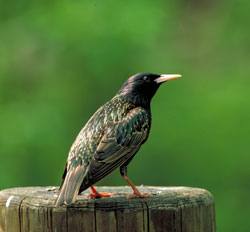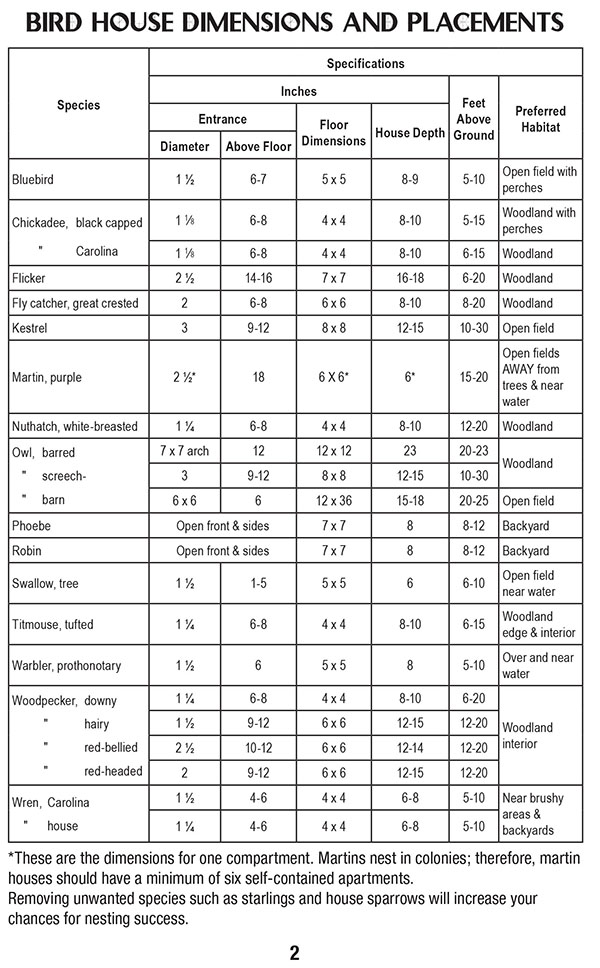Alaska Fish & Wildlife News
May 2022
Bird Box Tips
By Arin Underwood

A swallow nest box. This size is good for a variety of the smaller cavity nesting birds.
Mark Findlay offered advice and insights for building better bird boxes, and tips for nesting success.
- Make bird boxes out of thick cedar boards. Swallows need to be at least 5x5" or else it will be too small and babies won’t have room and can die. 5.5x5.5 is better.
- Nest boxes don’t have to be perfect or even airtight or square
- Roosting boxes are good for winter so birds can hide from wind. Hole in bottom and a peg to sit on
- Boxes must be cleaned every year at least to prevent spread of disease. Take down for winter, clean, and store
- If you stain or paint the outside of a box, let it sit for 3 days to give the air a chance to clear so the box won’t smell too strongly inside
- If a bird has not moved into a box after you see them checking it out for a few days, check inside. Sometimes paper wasps move in and deter birds.
- If you live in windy area, place nest boxes on lee side of trees to reduce wind on the box. A chickadee box can go on a post or on tree, which does provide better cover. Build the roof with a 1.5” overhang to keep out rain from the entrance
- Keep boxes well off the ground (at least a few feet). Domestic cats are one of the most destructive invasive species in the world. They will kill small birds. Consider keeping domestic cats indoors to both protect them from car strike and disease and protect small birds and mammals.
- Bumblebees sometimes move into swallow boxes, which is not necessarily a bad thing. Bees need habitat too, and are valuable pollinators
- Decide what species you want. Do research on plans, if more than one source agrees on dimensions and instructions then that’s a good sign it might work
- For chickadees, they can warm their eggs and chicks but have no way to cool them. So, some ventilation can help. Cutting a ¼” slit across both sides instead of drilling a ton of holes can help with ventilation (a lot of online plans call for drilling holes for ventilation)
- Drill two holes in bottom of box as a drain
- Timeline: Mark has put out a chickadee box by mid-April in the past. Chickadees will check it out, maybe not go in though. As they get more serious they will start to go in. One will go in and hang out for 5-10 minutes just getting a feel for it, then they will start to gather moss and spend 3-4 days building a nest and lay eggs within another day or so. 5/15 they started using nest box, 5/26 nest is built.
- Mark puts deck stain or sealant on all his nest boxes, and uses light colored paint. Bird boxes don’t need paint like bat boxes do. It will get too hot for them.
- Ideally put up chickadee boxes 12 ft in the air away from predators, 20 ft away from high human traffic, including front doors. They like quiet.
- If you make an entrance hole in bird box out of a different wood, harder than cedar, it can deter squirrels from messing with it
Extra Notes
- Monitor nest boxes for starling use. Starlings are an invasive species, and we do not want them to nest successfully. Nest boxes with holes smaller than 1.5” can keep them out. If it’s big enough for them though (like an owl-size box), then monitor the box. If you see starlings start to use it, then remove nesting material. Starlings are not protected by Migratory Bird Treaty Act since they are non-native. Place boxes away from urban areas where starlings congregate.
- Nest boxes create more habitat as natural cavities in snags or dead trees are often destroyed or removed by humans. Save a snag for wildlife http://www.adfg.alaska.gov/index.cfm?adfg=livingwithbirds.birdhousesnag
- Be patient, nest box may not be occupied first year, may take several years
- Cleaning nest boxes and roosts at least once a year is critical to reduce chances of disease spread
- Bird feeders should be cleaned even more often

An invasive European starling. They are not protected by Migratory Bird Treaty Act since they are non-native. Monitor nest boxes for starling use and don't allow them to nest.

Subscribe to be notified about new issues
Receive a monthly notice about new issues and articles.
